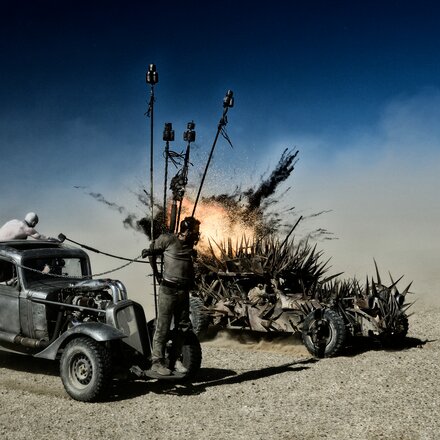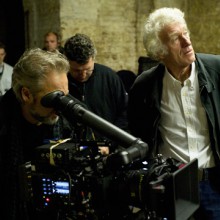Words by Quentin Falk, published on 26 March 2012
In charting the startling rise and rise of late blooming writer-director Andrea Arnold it is perhaps all too easy to forget the contribution of her most regular collaborators, of whom the most significant must surely be cinematographer Robbie Ryan BSC.
Irish-born Ryan first got together with Arnold on her 2003 award-winning short Wasp and has since been a firm right hand on her three features, Red Road, Fish Tank and, most recently, Wuthering Heights.
In between Arnold’s work, Ryan has separately built up a hugely impressive list of visually exciting credits including Brick Lane, The Scouting Book For Boys and the acclaimed C4 television drama, I Am Slave, which was nominated for a BAFTA in 2011.
And, since returning from the wilds of Yorkshire on Wuthering Heights, Ryan has become the latest addition to the Ken Loach ‘family’, following in the footsteps of great cameramen like Chris Menges and Barry Ackroyd, to shoot the veteran filmmaker’s upcoming feature, The Angel’s Share.
Ryan admits he was “quite nervous” at first about working with Loach, “but in fact he’s surrounded by regular people who were very welcoming. There were no pretensions or expectations; they just wanted you to be part of the family. It was a real privilege for me, he’s a legend – and a total gentleman.”
Loach’s more observational style, often with a long lens – “witnessing life without being intrusive, the camera is not there, really,” as Ryan describes – could hardly be more different from Arnold’s. “Hers is all about being on top of the person, walking about with them. The camera is definitely a character in her film.”
"Ken Loach's style is about witnessing life without being intrusive. The camera is not there, really. Andrea Arnold’s camera is all about being on top of the person, walking about with them."
That was never more the case than in Wuthering Heights which was arguably the most immersive yet of all Arnold and Ryan’s work together. Quite literally on occasion as Ryan, shod in football boots to try and avoid slipping while he tackled 45 degree slopes with a hand-held camera, was often almost knee deep in Yorkshire mud.
“Bloody hell!” was his first reaction when he heard that Arnold wanted to film Emily Bronte’s 19th Century classic, a book he’d last read for an exam as a 17-year-old in his final year at school and hadn’t greatly enjoyed. Originally she’d talked to him rather mysteriously “about a film in Ireland using candles. I never thought she’d pick such an established period drama which had probably been done about 15 times before.”
Ryan decided to re-read the book and admits he enjoyed it a bit more the second time round. He didn’t, however, watch any of the previous film adaptations unless you count a couple of YouTube clips of William Wyler’s much-loved, tear-jerking 1939 version, with Laurence Olivier and Merle Oberon, shot on 450 acres of California ‘moors’ famously sprinkled with imported Yorkshire heather.
“Of course, I knew that she’d do something different to it, bring a new voice and interpretation to the story,” says Ryan. “She gives me a lot of freedom to express myself to do what I think she’ll want. She often has imagery very clear in her head. For instance, there’s a scene of Heathcliff behind Cathy on a horse and she wanted Cathy’s hair going across the lens.”
However, until they finally found the locations they finally wanted the ‘look’ was still somewhat in the lap of the gods. “We went up and did a test day,” Ryan recalls, “and it was quite miserable. ‘That’d be great,’ we both thought because then it’d be suitably ‘Wuthering’. But when we actually started filming – from mid-September through to the end of November – the landlady in the local pub told us that October was going to be glorious for the whole month. ‘Nah, what are you talking about?’ we said. But she was right; we had bright blue skies.
“In fact it’s actually easier to make that kind of weather look miserable than to try and make miserable weather look lovely. The film had originally been due to go in April and we were worried that we’d have a whole summer of bright green, so I was secretly pleased when the film got put back and back.
“We knew that if we could film over the turn of the seasons, it’d reap dividends. And it did. It started off bright green and by the end of the shoot, it was rusty brown, and we even got some snow as well. We also got some lovely skies with clouds scudding across as well as those amazing landscapes.”
"We knew that if we could film over the turn of the seasons, it’d reap dividends. It started off bright green and by the end of the shoot, it was rusty brown."
In fact, the eventual ‘look’ supplemented by some machine and CG rain, also aided in no small part by an evocative natural soundtrack, would earn Ryan a Best Technical Achievement award – the Golden Osella – for his cinematography at the Venice Film Festival.
Ryan, a graduate of the Dun Laoghaire Institute of Art, Design and Technology, who has been shooting film since he was 14, has clearly come a remarkably long way for someone who still claims to be “stumbling about in the business. For me, there’s still no rhyme or reason to it. It’s often about being in the right place at the right time.”
He moved to England when he couldn’t get the kind of work he wanted in his native Ireland and made a point of trying to shoot as many drama shorts as he could take on because he was far more interested in the cinema than the commercials’ side of things. Just as he moved quickly between various forms of camera as a teenager, so he’d offer any aspiring cinematographer the same advice.
“Nowadays you can just grab a DSLR or even your iPhone, and make imagery. It’s a question of getting your eye to a camera. That’s where you learn about composition, by shooting the world around you. It doesn’t have to be lit in any special way; there’s always natural light. If you can create an interest in the everyday world around you, then you’re probably going in the right direction.”
Ryan, who names cinematographers like Lance Acord, Harris Savides, Anthony Dod Mantle and Wally Pfister, not to mention Cesar Charlone (“what he did on City Of God was amazing”) as fellow DPs he particularly admires, is also quick to acknowledge the huge influence on him and his subsequent career of Andrea Arnold herself. “In many ways, it’s all down to Andrea and her distinctive style,” he adds, modestly.
Working on Wuthering Heights certainly offered Ryan some of his more severe challenges to date. Asked to name the hardest scenes to film, he would cite “all the night-time firelight stuff. Andrea wanted it to be as natural and organic looking as possible, and at times my gaffer and I really struggled with that. People have said to me since, ‘it looks really dark’. And I think, ‘great, I must have got away with it,” he laughs.
As for the scenes of which he’s proudest, Ryan extols the virtues of the compact 35mm Eyemo camera – sometimes nicknamed “crash cam” because of its versatility, portability and, on occasion, expendability. “I could run around with it to get a sense of emotion and pure energy. Yes, anywhere I used that, usually where the action was crazy, like a fight.”
Ryan, currently in pre-production with filmmaker Sally Potter on her new feature Bomb, set in London during the “Swinging Sixties,” says he has absolutely no plans to turn director himself.
“In a way I can do a lot of directing from camera but without all the extra baggage a director has to have. I can be more blunt and pure in terms of the visual storytelling without being affected by the outside stuff and hope they can respond to that. To me, that’s the best kind of direction.”



 Episode - The Haunting _1477407288.jpg)


